- Established 1982 -HOME: www.hiltonpond.org
THIS WEEK at HILTON POND Subscribe for free to our award-winning nature newsletter (Back to Preceding Week; on to Next Week) |
HUMMINGBIRDS APLENTY, Ruby-throated Hummingbirds (RTHU) are the story of the summer at Hilton Pond Center as they continue to cross our banding table in record numbers for this time of year. Through 31 July we had banded 141 RTHU, 13 days ahead of the previous record pace set just last year. On average in our 40 years of ruby-throat study at the Center we have banded only 66 by the end of July, so with more than six weeks left in the season we already have more than twice that and a chance of breaking our all-time annual record of 373 set in 2016. (That year we banded 100 hummers through July, compared to this year's 141.) One never knows, however, and the bottom could fall out as the dog days of August arrive; we never know how successful the banding season has been until the last hummers are gone by mid-October.
All text, maps, charts & photos © Hilton Pond Center Interestingly, this week we caught an unbanded adult male Ruby-throated Hummingbird with a full red gorget, but he also showed chin and forehead molt (above)--evidenced by numerous feathers still encased in sheaths. By late July it's not uncommon to capture adult RTHU (and occasional immatures) with such prominent body molt; our local hummers often start the process even before migrating to the Neotropics where they finish the job. Unless due to accidental loss, however, they never molt flight feathers--wings and tail--until they arrive on the non-breeding grounds. And speaking of migration, just as adult male ruby-throats are first to arrive at the Center come spring, they're also first to depart after breeding season is over. In fact, it's likely some adult male RTHU from the Carolinas and north of us start their southbound trip as early as the first week in August. Makes sense: They've done their job here so they might as well fly to Central America, where we've seen male Ruby-throated Hummingbirds establishing and defending territories among nectar-rich Aloe Vera plantations in Guanacaste Province, Costa Rica (below)--just as they do up here on the breeding grounds.
All text, maps, charts & photos © Hilton Pond Center Perhaps it's important for those adult males to head out as soon as possible after breeding is finished, lest they end up with sub-optimal territories down south. Oddly, young males are usually the last to leave Hilton Pond each fall. Perhaps they need their bodies to mature before setting off on their first long flight south. If any adult male Ruby-throated Hummingbirds are indeed getting ready to depart Hilton Pond Center, it's probably in their best interest to be drinking carbohydrate-laden nectar and sugar water. This fuels them enough to capture tiny fat- and protein-rich insects and other invertebrates they convert to longer-lasting, energy-rich stored fat for the long journey.
All text, maps, charts & photos © Hilton Pond Center This far north they need not reach maximum fat-weight, since for at least the first part of the southbound trip they'll be flying entirely overland across Georgia (and beyond) and can refuel along the way. It's only if they take a non-stop trip across the Gulf of Mexico that they'll nearly need to double their mass for what could be a 20-hour trip. (Flying along the Caribbean curve of Mexico might actually be a safer strategy than going trans-Gulf, and it's likely at least some ruby-throats follow that path. These still might put on some fat, however.) In any case, adult male RTHU were hitting the Center's feeders this week--even though they had to compete with Honeybees (see photo above) whose thirst for sugar water mix was just as great. All text, maps, charts & photos © Hilton Pond Center TULIP TREES AND MOTHS We were closing our mist nets after banding birds one evening this week when out of the corner of our eye saw movement on a nearby hardwood trunk. We turned to get a better view but couldn't figure out what we'd seen--until we got much closer to the tree and found the culprit: A two-and-a-half-inch-wide grayish-brown moth (below), wings spread and flattened against closely matched bark. (To the naked eye the moth was even more camouflaged; our camera flash made its wings stand out against the bark.)
All text, maps, charts & photos © Hilton Pond Center Because of its size, scalloped hindwings, color, and general zigzag patterning, we recognized this insect as a Tulip-Tree Beauty, Epimecis hortaria. It's one of the larger members of the Geometer Moth Family (Geometridae), so-called because their larvae--known as inchworms--appear to "measure the Earth" as they crawl along twigs in search of food. In the case of Tulip-Tree Beauty caterpillars, that food is the leaves of Pawpaw, Sassafras, and members of the Magnolia Family--including the Tulip Tree (below) for which the species is named. (Yes, Tulip Trees, Liriodendron tulipifera, aka Yellow Poplars, are actually magnolias! And their springtime flowers--often high in the canopy--are a favorite nectar source for Ruby-throated Hummingbirds!) In the mid 1930s there was an unprecedented outbreak of Tulip-Tree Beauty caterpillars in Connecticut--so many that sassafras trees across the state were denuded of foliage--a phenomenon apparently not reported since.
All text, maps, charts & photos © Hilton Pond Center Tulip-Tree Beauty butterfly ranges from New England south to Florida and west to the eastern edge of the Great Plains States. (There apparently are confirmed disjunct records from Dominican Republic and Costa Rica.) Individual wing markings vary greatly and there is even a dark form that is nearly black. Adults are active mid-spring through early autumn and are attracted to lights; they dine on flower nectar and live no longer than several weeks. The Tulip-Tree Beauty we encountered at Hilton Pond Center apparently was a female, based up on her simple antennae structure (see top photo for the hair-like structures arising from near the moth's eyes). Males have wide, feathery antennae adapted to pick up faint windblown molecules of sexual pheromones released by females seeking a mate. All text, maps, charts & photos © Hilton Pond Center SWAMP MILKWEED AND A HUMMINGBIRD MOTH We don't host a plethora of native wildflowers on Hilton Pond Center's 11 acres--more than a century of row cropping and livestock grazing by previous owners pretty much depleted the soil of wild plants, seeds, and rootstock--and as part of our "wait and watch" philosophy of land management we've chosen not to install a lot of trees, shrubs, vines, or herbaceous flora. Natural succession is the name of our game, although this means plenty of non-native plants have invaded the property. Thus, we were excited about 30 years ago when native Swamp Milkweed, Asclepias incarnata (below), colonized several spots along the bank of the pond.
All text, maps, charts & photos © Hilton Pond Center As is the case with other milkweeds, few mammalian or insect browsers munch on Swamp Milkweed foliage, although we do occasionally find Monarch larvae dining on the leaves. The plant seems more important as a nectar source for a variety of insects, and in three decades of observation we've documented more than 20 kinds of beetles, bugs, flies, wasps, bees, and butterflies partaking of the milkweed's pollen or nectar. This week we added a day-flying moth to the species list.
All text, maps, charts & photos © Hilton Pond Center "Diurnal" and "moth" are not words that usually go together, but in the case of the Snowberry Clearwing, Hemaris diffinis (above), they're entirely appropriate. The species is a hummingbird mimic--one of the so-called "Hummingbird Moths"--that has scale-less wings, hovers, extends a black bill-like proboscis to feed on flower nectar, and behaves for all the world like a real hummingbird. (Folks with a bias toward invertebrates say this moth is a "Bumblebee mimic.") Although the moth even spreads its tail like a hummer, two prominent antennae (and six legs!) are a giveaway it's not really a tiny bird. (NOTE: We often get inquiries from folks claiming they have "baby hummingbirds" hovering and feeding in their flower gardens. Those are undoubtedly hummingbird moths; among other things, baby hummingbirds can't fly!) There are several other hummingbird moths--they're all in the Sphinx Moth or Hawk Moth Family (Sphingidae)--but Snowberry Clearwing is the only one we've seen at Hilton Pond Center. It's nice to have that patch of self-planted Swamp Milkweed that attracts them. All text, maps, charts & photos © Hilton Pond Center HILTON POND SUNSETS (AND SUNRISES) "Never trust a person too lazy to get up for sunrise
Sunset over Hilton Pond, 28 July 2023 With rolling thunder just to our north, the weather gods were teasing us and sent no rain to wet the soil and cool high temperatures. All text, maps, charts & photos © Hilton Pond Center Don't forget to scroll down for lists of Hilton Pond supporters and of all birds banded and recaptured during the period. Photoshop image post-processing for this page employs |
|---|
|
"This Week at Hilton Pond" is written and photographed by Dr. Bill Hilton Jr., executive director of Hilton Pond Center for Piedmont Natural History
|
|
|
Please refer "This Week at Hilton Pond" to others by clicking on this button: |
|


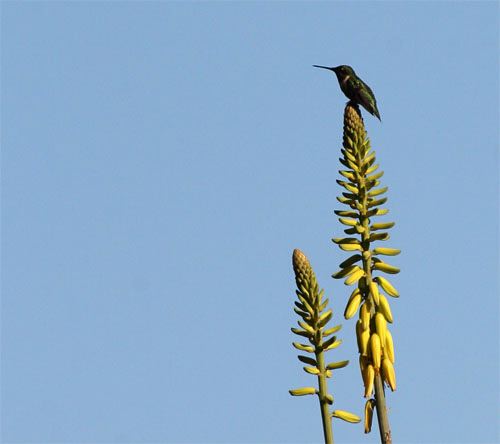
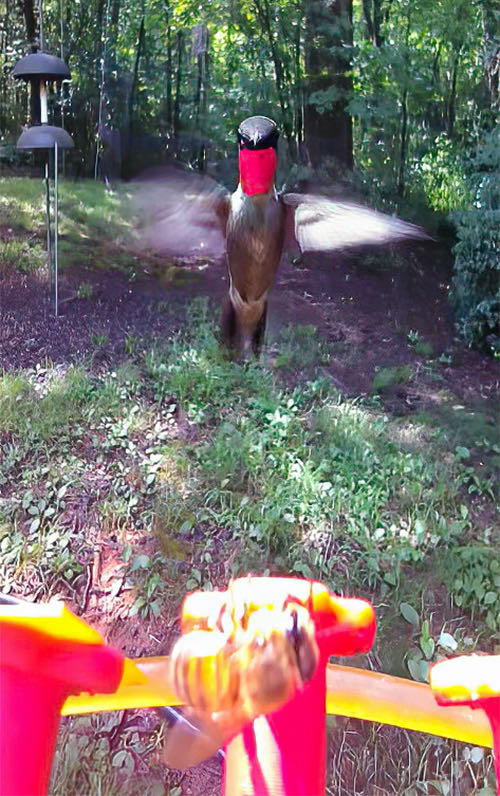

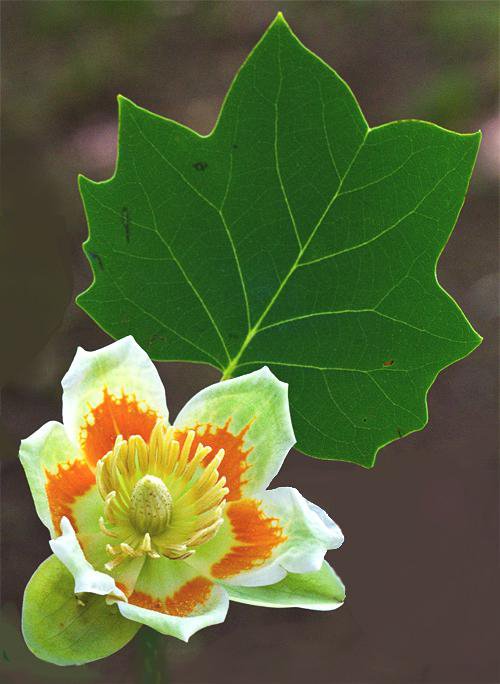
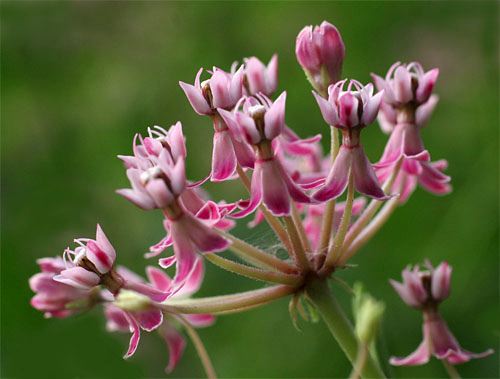
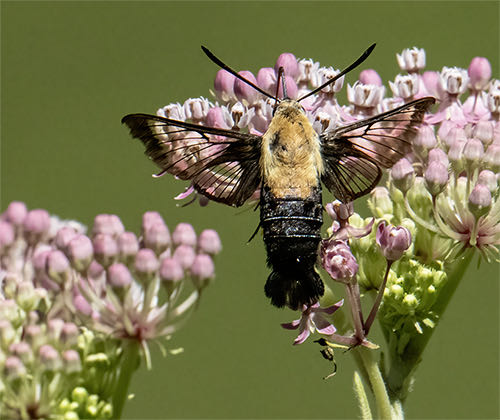
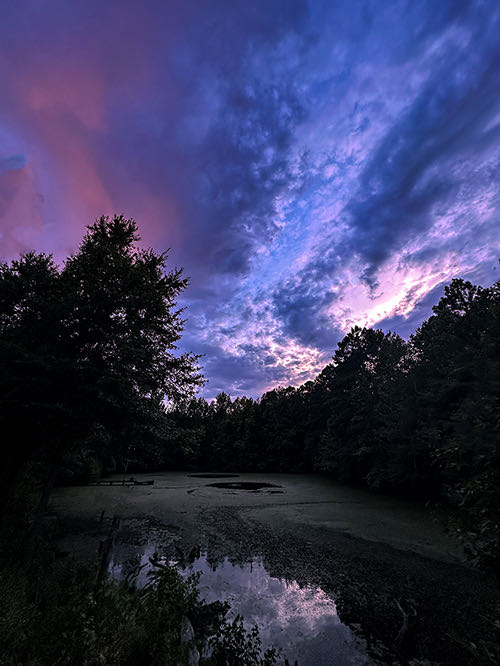









 Please report your spring, summer &
Please report your spring, summer &